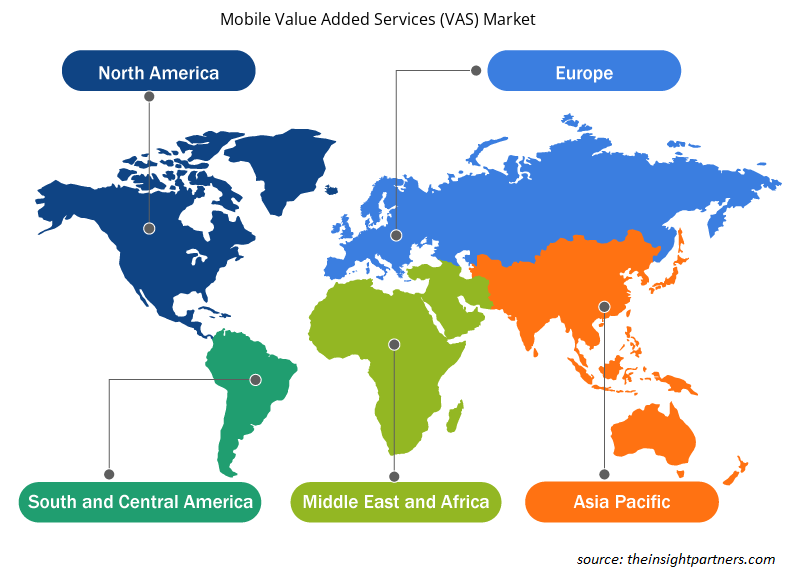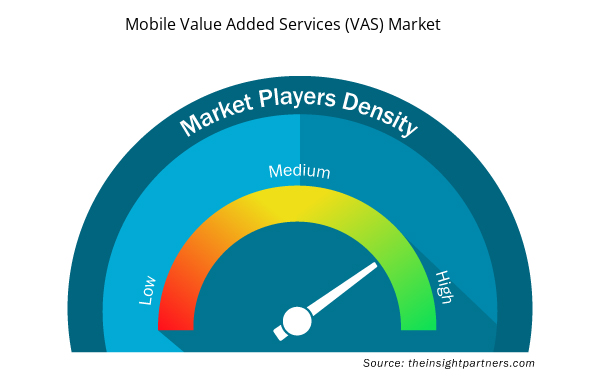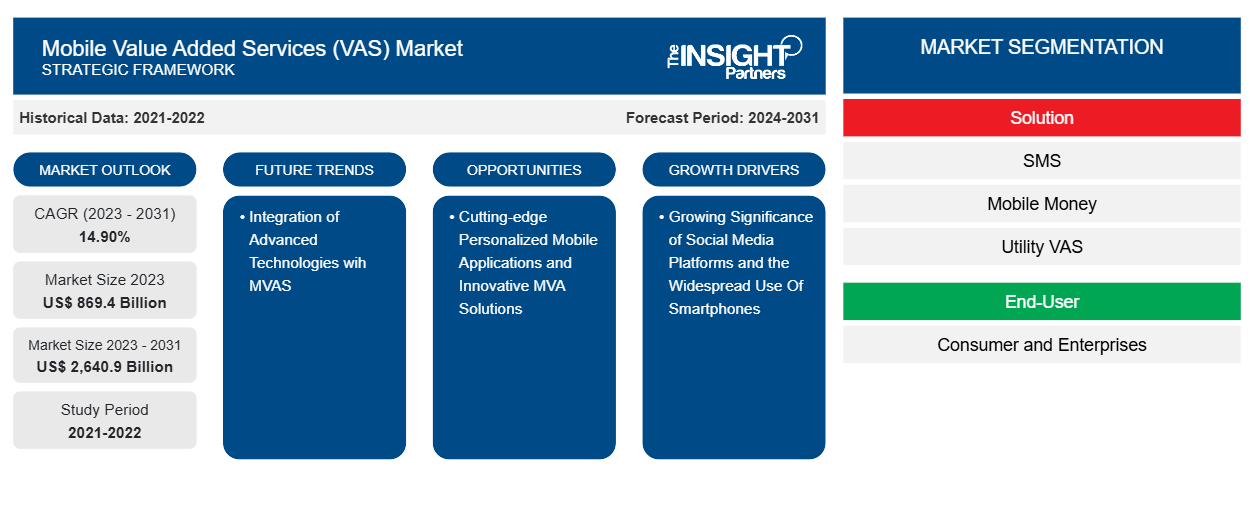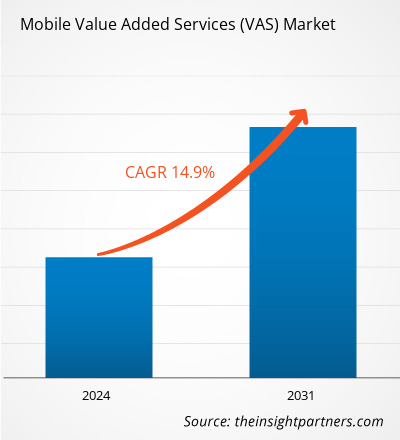モバイル付加価値サービス (VAS) 市場規模は、2023 年の 8,694 億米ドルから 2031 年には 2 兆 6,409 億米ドルに達すると予測されています。市場は 2023 年から 2031 年にかけて 14.90% の CAGR を記録すると予想されています。ソーシャル メディア プラットフォームの影響の拡大とスマートフォンの普及は、モバイル付加価値サービス (VAS) 市場の主要トレンドであり続けると思われます。
モバイル付加価値サービス (VAS) 市場分析
リーズナブルなコストで、さまざまなコンテンツや更新されたコンテンツに簡単にアクセスできるようになったことで、モバイル付加価値サービスの一部である OTT の成長が加速しています。通信会社は、Netflix などのエンターテイメント業界のオンライン視聴プラットフォームと連携して VAS を提供しています。このような連携は、支払い、コンテンツ配信、インタラクティブ マーケティング、顧客ケアの面で VAS に貢献しています。
モバイル付加価値サービス (VAS) 市場の概要
モバイル付加価値サービス (MVAS) には、音声通信サービスや、モバイル サービス プロバイダーが提供するその他の追加サービスが含まれます。これらのサービスにより、モバイル加入者は、ショート メッセージ サービス (SMS)、マルチメディア メッセージ サービス (MMS)、モバイル メールとインスタント メッセージ、モバイル マネー、位置情報サービス、モバイル広告、モバイル インフォテインメントなど、音声以外のさまざまな用途にスマートフォンやタブレットを利用できます。MVAS は、プレミアム機能または必須サービスの補足として販売されており、幅広いサービスの管理と運用の効率化に活用されています。MVAS は、エンド ユーザーの機能性を高め、商用利用のための分析とデータを改善することで、サービス プロバイダーとクライアントの両方にメリットをもたらします。
要件に合わせてレポートをカスタマイズする
このレポートの一部、国レベルの分析、Excelデータパックなど、あらゆるレポートを無料でカスタマイズできます。また、スタートアップや大学向けのお得なオファーや割引もご利用いただけます。
- このレポートの主要な市場動向を入手してください。この無料サンプルには、市場動向から見積もりや予測に至るまでのデータ分析が含まれます。
モバイル付加価値サービス(VAS)市場の推進要因と機会
ソーシャルメディアプラットフォームの重要性の高まりとスマートフォンの普及
多種多様なベンダーとインターネット サービス プロバイダー間の熾烈な競争により、デジタル ソリューション、高度なアプリケーション、および多数の付加価値サービスが高度に実装されています。スマートフォンは、オンライン Web サイトの閲覧、電子メールの共有、ソーシャル メディア プラットフォームでのやり取りなど、さまざまなインターネット アプリケーションへのアクセスに利用されています。通信プロバイダーは、全体的なユーザー エクスペリエンスを向上させるために、音声、SMS、データ サービスなどのさまざまなモバイル付加価値サービスを提供しています。手頃な価格のスマートフォンがますます利用できるようになっていることが、低所得者層の間でデバイスの採用を促進する重要な要因であり、世界中のモバイル付加価値サービスの需要に貢献しています。したがって、ソーシャル メディア プラットフォームの重要性の高まりとスマートフォンの普及は、モバイル付加価値サービス (VAS) 市場の成長を促進する重要な要因です。
最先端のパーソナライズされたモバイルアプリケーションと革新的なMVAソリューション
進化する消費者の需要に応えるため、世界中の通信事業者やサービス プロバイダーが、斬新で独創的なパーソナライズされたモバイル アプリケーションやモバイル付加価値サービス (VAS) を多種多様に導入しています。モバイル VAS 加入者やスマートフォン ユーザーの増加などの要因によって、市場環境は変化しています。さらに、企業と消費者の両方からカスタマイズされた付加価値サービスが求められていることも、モバイル付加価値サービス (VAS) 市場の拡大につながっています。この傾向は、最先端のモバイル ソリューションとサービスを通じて、消費者と企業の進化するニーズに応えるという業界の取り組みを浮き彫りにしています。
モバイル付加価値サービス (VAS) 市場レポートのセグメンテーション分析
モバイル付加価値サービス (VAS) 市場分析の導出に貢献した主要なセグメントは、ソリューションとエンド ユーザーです。
- ソリューションに基づいて、市場はSMS、モバイルマネー、ユーティリティVAS、モバイルインフォテインメント、ソーシャルネットワーキング、位置情報サービス、その他に分類されています。SMSセグメントは2023年にかなりの市場シェアを占めました。
- エンドユーザー別に見ると、市場は消費者と企業に分かれています。2023年には消費者セグメントが市場で大きなシェアを占めました。
モバイル付加価値サービス (VAS) の地域別市場シェア分析
モバイル付加価値サービス (VAS) 市場レポートの地理的範囲は、主に北米、アジア太平洋、ヨーロッパ、中東およびアフリカ、南米および中米の 5 つの地域に分類されています。
アジア太平洋地域には携帯電話のユーザーが多く、これらのデバイスは主にニュースや映画の視聴、モバイルバンキングなどの娯楽目的で使用されています。アジア太平洋地域のモバイル付加価値サービス (VAS) 市場の成長は、さまざまなモバイル付加価値サービスを利用する企業や業界の増加と、この地域での小売、電子商取引、IT および通信セクターの繁栄に起因しています。
モバイル付加価値サービス (VAS) 市場の地域別分析
予測期間を通じてモバイル付加価値サービス (VAS) 市場に影響を与える地域的な傾向と要因は、Insight Partners のアナリストによって徹底的に説明されています。このセクションでは、北米、ヨーロッパ、アジア太平洋、中東およびアフリカ、南米および中米にわたるモバイル付加価値サービス (VAS) 市場のセグメントと地理についても説明します。

- モバイル付加価値サービス(VAS)市場の地域別データを入手
モバイル付加価値サービス(VAS)市場レポートの範囲
| レポート属性 | 詳細 |
|---|---|
| 2023年の市場規模 | 8,694億米ドル |
| 2031年までの市場規模 | 2兆6,409億米ドル |
| 世界のCAGR(2023年~2031年) | 14.90% |
| 履歴データ | 2021-2022 |
| 予測期間 | 2024-2031 |
| 対象セグメント | ソリューション別
|
| 対象地域と国 | 北米
|
| 市場リーダーと主要企業プロフィール |
|
モバイル付加価値サービス (VAS) 市場のプレーヤー密度: ビジネスダイナミクスへの影響を理解する
モバイル付加価値サービス (VAS) 市場は、消費者の嗜好の変化、技術の進歩、製品の利点に対する認識の高まりなどの要因により、エンドユーザーの需要が高まり、急速に成長しています。需要が高まるにつれて、企業は提供内容を拡大し、消費者のニーズを満たすために革新し、新たなトレンドを活用し、市場の成長をさらに促進しています。
市場プレーヤー密度とは、特定の市場または業界内で活動している企業または会社の分布を指します。これは、特定の市場スペースに、その市場規模または総市場価値に対してどれだけの競合相手 (市場プレーヤー) が存在するかを示します。
モバイル付加価値サービス (VAS) 市場で事業を展開している主要企業は次のとおりです。
- 労働所得税
- エアテル(ロビ・アシアタ・リミテッド)
- モビリー
- MTNカメルーン
- Numeko Bili?im Teknoloji Sanayi Ticaret A.?.
- オマーン通信会社
免責事項:上記の企業は、特定の順序でランク付けされていません。

- モバイル付加価値サービス(VAS)市場のトップキープレーヤーの概要を入手
モバイル付加価値サービス(VAS)市場のニュースと最近の動向
モバイル付加価値サービス (VAS) 市場は、主要な企業出版物、協会データ、データベースなどの一次調査と二次調査を経て定性的および定量的データを収集することで評価されます。モバイル付加価値サービス (VAS) 市場の動向のいくつかを以下に示します。
- 革新的なテクノロジーと通信ソリューションを提供する急成長中のグローバル通信会社 Monty Mobile は、AI と機械学習を付加価値サービス (VAS) に統合すると発表しました。OmniVAS と呼ばれるこの統合により、モバイル オペレーターはすぐに収益を 2 桁に増やすことができます。データ マイニングを活用するこの最先端の AI ソリューションは、消費者の行動を自動的に分析し、アップセルとクロスセルを最適化します。これは顧客満足度の向上に直接影響し、販売を促進してオペレーターの収益を増加させ、機械学習と驚くべき洞察を通じて顧客行動の理解を深め、インテリジェントな意思決定と予測を可能にします。(出典: Monty Mobile、プレス リリース、2023 年)
- チャットコマースとビジネスメッセージングのリーダーであるClickatellは、南アフリカ最大の総合通信会社Telkom向けにChat 2 Pay機能を開始しました。Telkomの何百万人もの顧客は、同国最大のチャットチャンネルであるWhatsAppで支払いを行うことができます。(出典: Clickatell、企業ウェブサイト、2023年)
モバイル付加価値サービス (VAS) 市場レポートの対象範囲と成果物
「モバイル付加価値サービス(VAS)市場規模と予測(2021〜2031年)」レポートでは、以下の分野をカバーする市場の詳細な分析を提供しています。
- モバイル付加価値サービス(VAS)市場規模と予測(対象範囲に含まれるすべての主要市場セグメントの世界、地域、国レベル)
- モバイル付加価値サービス(VAS)市場の動向、推進要因、制約、主要な機会などの市場動向
- 詳細なPEST/ポーターの5つの力とSWOT分析
- 主要な市場動向、世界および地域の枠組み、主要プレーヤー、規制、最近の市場動向を網羅したモバイル付加価値サービス(VAS)市場分析
- モバイル付加価値サービス(VAS)市場の市場集中、ヒートマップ分析、主要プレーヤー、最近の動向を網羅した業界展望と競争分析
- 詳細な企業プロフィール
- 過去2年間の分析、基準年、CAGRによる予測(7年間)
- PEST分析とSWOT分析
- 市場規模価値/数量 - 世界、地域、国
- 業界と競争環境
- Excel データセット



Report Coverage
Revenue forecast, Company Analysis, Industry landscape, Growth factors, and Trends

Segment Covered
This text is related
to segments covered.

Regional Scope
North America, Europe, Asia Pacific, Middle East & Africa, South & Central America

Country Scope
This text is related
to country scope.
よくある質問
The market is expected to reach US$ 2,640.9 billion by 2031.
The key players holding significant shares in the market are EITC, Airtel (Robi Axiata Limited), Mobily Orange S.A., Stc, and Vodafone Limited.
Cutting-edge personalized mobile applications and innovative MVA solutions are anticipated to play a significant role in the market in the coming years.
The growing significance of social media platforms and the widespread use of smartphones are the major factors that propel the market.
The market was estimated to be US$ 869.4 billion in 2023 and is expected to record a CAGR of 14.90% from 2023 to 2031.
Trends and growth analysis reports related to Technology, Media and Telecommunications : READ MORE..
The Insight Partners performs research in 4 major stages: Data Collection & Secondary Research, Primary Research, Data Analysis and Data Triangulation & Final Review.
- Data Collection and Secondary Research:
As a market research and consulting firm operating from a decade, we have published and advised several client across the globe. First step for any study will start with an assessment of currently available data and insights from existing reports. Further, historical and current market information is collected from Investor Presentations, Annual Reports, SEC Filings, etc., and other information related to company’s performance and market positioning are gathered from Paid Databases (Factiva, Hoovers, and Reuters) and various other publications available in public domain.
Several associations trade associates, technical forums, institutes, societies and organization are accessed to gain technical as well as market related insights through their publications such as research papers, blogs and press releases related to the studies are referred to get cues about the market. Further, white papers, journals, magazines, and other news articles published in last 3 years are scrutinized and analyzed to understand the current market trends.
- Primary Research:
The primarily interview analysis comprise of data obtained from industry participants interview and answers to survey questions gathered by in-house primary team.
For primary research, interviews are conducted with industry experts/CEOs/Marketing Managers/VPs/Subject Matter Experts from both demand and supply side to get a 360-degree view of the market. The primary team conducts several interviews based on the complexity of the markets to understand the various market trends and dynamics which makes research more credible and precise.
A typical research interview fulfils the following functions:
- Provides first-hand information on the market size, market trends, growth trends, competitive landscape, and outlook
- Validates and strengthens in-house secondary research findings
- Develops the analysis team’s expertise and market understanding
Primary research involves email interactions and telephone interviews for each market, category, segment, and sub-segment across geographies. The participants who typically take part in such a process include, but are not limited to:
- Industry participants: VPs, business development managers, market intelligence managers and national sales managers
- Outside experts: Valuation experts, research analysts and key opinion leaders specializing in the electronics and semiconductor industry.
Below is the breakup of our primary respondents by company, designation, and region:

Once we receive the confirmation from primary research sources or primary respondents, we finalize the base year market estimation and forecast the data as per the macroeconomic and microeconomic factors assessed during data collection.
- Data Analysis:
Once data is validated through both secondary as well as primary respondents, we finalize the market estimations by hypothesis formulation and factor analysis at regional and country level.
- Macro-Economic Factor Analysis:
We analyse macroeconomic indicators such the gross domestic product (GDP), increase in the demand for goods and services across industries, technological advancement, regional economic growth, governmental policies, the influence of COVID-19, PEST analysis, and other aspects. This analysis aids in setting benchmarks for various nations/regions and approximating market splits. Additionally, the general trend of the aforementioned components aid in determining the market's development possibilities.
- Country Level Data:
Various factors that are especially aligned to the country are taken into account to determine the market size for a certain area and country, including the presence of vendors, such as headquarters and offices, the country's GDP, demand patterns, and industry growth. To comprehend the market dynamics for the nation, a number of growth variables, inhibitors, application areas, and current market trends are researched. The aforementioned elements aid in determining the country's overall market's growth potential.
- Company Profile:
The “Table of Contents” is formulated by listing and analyzing more than 25 - 30 companies operating in the market ecosystem across geographies. However, we profile only 10 companies as a standard practice in our syndicate reports. These 10 companies comprise leading, emerging, and regional players. Nonetheless, our analysis is not restricted to the 10 listed companies, we also analyze other companies present in the market to develop a holistic view and understand the prevailing trends. The “Company Profiles” section in the report covers key facts, business description, products & services, financial information, SWOT analysis, and key developments. The financial information presented is extracted from the annual reports and official documents of the publicly listed companies. Upon collecting the information for the sections of respective companies, we verify them via various primary sources and then compile the data in respective company profiles. The company level information helps us in deriving the base number as well as in forecasting the market size.
- Developing Base Number:
Aggregation of sales statistics (2020-2022) and macro-economic factor, and other secondary and primary research insights are utilized to arrive at base number and related market shares for 2022. The data gaps are identified in this step and relevant market data is analyzed, collected from paid primary interviews or databases. On finalizing the base year market size, forecasts are developed on the basis of macro-economic, industry and market growth factors and company level analysis.
- Data Triangulation and Final Review:
The market findings and base year market size calculations are validated from supply as well as demand side. Demand side validations are based on macro-economic factor analysis and benchmarks for respective regions and countries. In case of supply side validations, revenues of major companies are estimated (in case not available) based on industry benchmark, approximate number of employees, product portfolio, and primary interviews revenues are gathered. Further revenue from target product/service segment is assessed to avoid overshooting of market statistics. In case of heavy deviations between supply and demand side values, all thes steps are repeated to achieve synchronization.
We follow an iterative model, wherein we share our research findings with Subject Matter Experts (SME’s) and Key Opinion Leaders (KOLs) until consensus view of the market is not formulated – this model negates any drastic deviation in the opinions of experts. Only validated and universally acceptable research findings are quoted in our reports.
We have important check points that we use to validate our research findings – which we call – data triangulation, where we validate the information, we generate from secondary sources with primary interviews and then we re-validate with our internal data bases and Subject matter experts. This comprehensive model enables us to deliver high quality, reliable data in shortest possible time.


 このレポートの無料サンプルを入手する
このレポートの無料サンプルを入手する